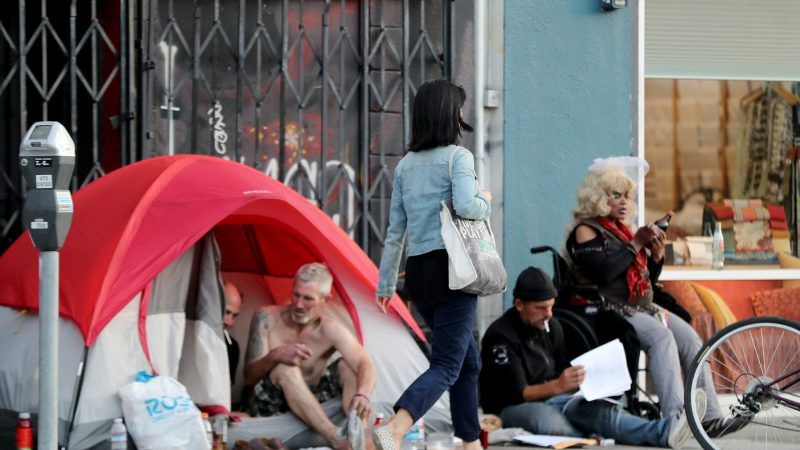New Numbers Show San Francisco's Homeless Population Has Grown by 30 Percent
This is nearly double the increase the city first reported in May.

San Francisco's homelessness problem has gone from bad to worse.
Last Friday, the city published an updated report on its homeless population, finding that the number of people without permanent housing had risen to 9,784. That's a 30 percent increase from the count taken in 2017, and nearly double the 17 percent increase the city first reported in May.
The difference can be chalked up to dueling federal and city definitions of who counts as homeless.
The U.S. Department of Housing and Urban Development's (HUD) definition of homelessness includes only those people living on the streets, in vehicles, or in temporary shelters. San Francisco has traditionally used a more expansive categorization that also counts people without a permanent address who are in jail, in the hospital, or in rehabilitation facilities.
The numbers released by the city in May relied on HUD's definition and found that the city's homeless population had risen from 6,858 to 8,011 people (a 17 percent increase). The data released last Friday—which relies on the city's own definition of homelessness—showed a jump from 7,499 to 9,784, adding up to that 30 percent increase.
The city says it initially reported the HUD numbers to allow for a more apples-to-apples comparison between San Francisco and other cities.
"We're looking at the HUD numbers because it helps us work in collaboration with other places like Los Angeles or our neighboring counties," city spokesperson Jeff Cretan told the Los Angeles Times.
Homeless advocates were less than impressed with this explanation.
The City was trying to be sneaky… https://t.co/qlRQ5oG4Dg
— Kelley Cutler (@NutCheese) July 10, 2019
Regardless of which definition of homelessness is used, the numbers are grim and speak to a worsening problem compounded by the city's dire housing affordability crisis.
The number of homeless people is derived from the city's point-in-time survey, which sees teams of volunteers canvass the city to literally count those sleeping on streets and in shelters. These volunteers also conduct surveys of these people, providing a window into who is experiencing homelessness and how they ended up in that situation.
This count found that half the city's homeless population, some 5,180 people, were unsheltered, 2,381 were in emergency shelters or transitional housing, and another 1,773 were in jails, hospitals, or rehab facilities.
Some 63 percent of survey respondents said that an inability to afford rent was an obstacle for finding permanent housing, compared to 56 percent of respondents in 2017 and 48 percent of respondents in 2015. Another 37 percent reported the lack of a job or income. Nineteen percent reported a lack of money for moving expenses as an obstacle for finding permanent housing.
When asked what was the primary event that led to someone becoming homeless, 26 percent reported the loss of a job. Another 18 percent listed a drug or alcohol problem as the primary factor. Thirteen percent said an eviction led them to become homeless, while another 12 percent said an argument with family or roommates who asked them to leave was the cause. Only 5 percent blamed a straight rent increase for pushing them into homelessness.
The different instigators of homelessness suggest there's no silver bullet for ending the problem.
Allowing more housing construction in the city—which can only be made possible by stripping away San Francisco's many, many restrictions on residential development—would bring housing costs down, and help those who listed high rent as an obstacle.
More importantly, lifting restrictions on development would make it easier for middle-class and working poor San Franciscans to find housing on the private market without government subsidies. That would free up more public dollars to help those who are truly destitute.
For instance, nearly a third of the 645 affordable housing units constructed in San Francisco in 2018 were targeted at people making up to 120 percent of area median income, or $99,500. Another 401 of those units were reserved for people making no more than 80 percent of area median income, or $66,300, which technically counts as low-income in the city.
Some $77 million of the city's last $310 million affordable housing bond, passed in 2015, was spent subsidizing middle-income housing. Similarly, a new $600 million affordable housing bond that will go before voters in November would, if passed, spend much of its money subsidizing new units for people earning up to $68,000 a year.
In a functioning housing market, which San Francisco certainly doesn't have, these folks would be able to rely on private providers for their housing needs. What city taxpayers currently spend subsidizing them could then be redirected to helping the homeless, for whom housing affordability is only one problem among many.
Rent Free is a weekly newsletter from Christian Britschgi on urbanism and the fight for less regulation, more housing, more property rights, and more freedom in America's cities.


Show Comments (60)